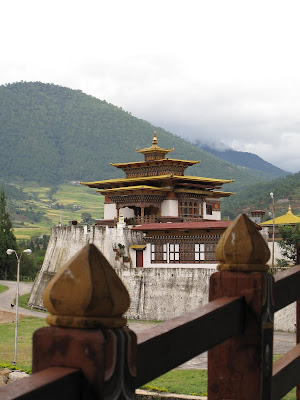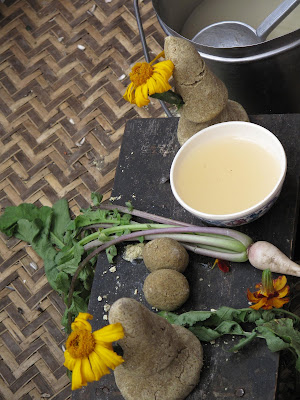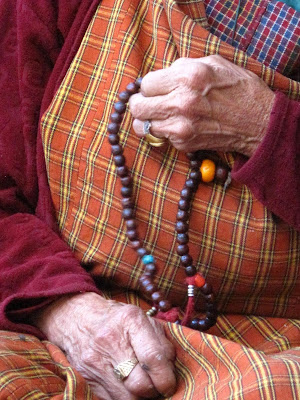


Paro and drive to Thimpu
We're sitting on the left hand of the plane as we head to Bhutan - and despite the thick clouds, the peaks of the Himalayan mountains become visible as we come closer to our destination,

I'm excited and full of anticipation. I've wanted to visit Bhutan - the land of the thunder dragon, a country which has never been colonised and until the 1960s was pretty much cut off from the rest of the world - for many years. The mantra for the country is now gross national happiness - a collective good which is rated above gross national product. Bhutan used to be ruled by hereditary monarchs until holding its first democratic elections in 2008.
Landlocked Bhutan is sandwiched between the world's two most populous countries, India and China. It has pursued a policy of insulation for many decades; and still puruses a policy designed to protect its cultural identity, though in the last decade, there have been dramatic changes: satellite television, the internet, and democratic elections which saw the country shift from an absolute monarchy to a parliamentary democracy.

Stepping off the plane the country doesn't disappoint. The small airport is traditional in architecture and colourfully painted. Airport staff wear the traditional dress - gho for men (a knee high wrapped tunic held together tightly with a waistbelt) and a kira for women - also a beautifully decorated tunic held with pins at the neck and topped with a brocade jacket)
Outside its warm and sunny. Its so green and there are brightly coloured flowers
Our smiling guide Tshering tells us there are only 3 International flights into Bhutan (population est. at 700,000) each day. This year tourist arrivals will number about 37,000 - well up from the time when the government limited visitor arrivals to just 3000. But there were plans he said to build more hotels to accommodate as many as 200 000 by 2012. Most would have to travel by road from India unless there were changes to expand the existing airport.
Driving around the picturesque narrow lanes with white painted buildings and farmhouses around Paro it was hard to see how that could happen. "The infrastructure can cope", Tshering assured us. There's enough electricity (he told us hydropowered electricity is their country's top export earner followed by tourism) and that many new hotels were being built.
Our first stop after coffee was at Paro Dzhong, or citadel.
There was a new rule banning tourists from wearing t shirts. Some of my group, about to return to the car to find jackets or shirts, were told by the temple official that after all, it didn't matter - and were waved in with a smile.
We explore the dzhong. Near the entranced are some paintings depicting the circle of life. There are 3 animals in centre of wheel reprsenting the three poisons; snake (avoid being hot /short tempered); rooster (avoid sexual excesses) and cow (avoid laziness). Dharma can be achieved if you are pure in intention and avoid the 3 sins. But if you don't follow the path you can face a grim future with torture/reincarnation as animals


We have a delicious lunch sampling some traditional Bhutanese dishes - lots are in cheese sauce and of course a plate of spicy chillies - ema datsi- which we will later discover is part of every meal here. We love the spice.



We drive onto the capital, Thimpu, about an hour and a half away, to catch the end of the annual tsechu or festival. We walk to the dzhong but its raining hard. Many Bhutanese, dressed in their finest costumes, are drenched to the skin.
But the crowds are still queuing to receive spiritual blessings
Groups of dancers perform in front of the crowd
Its a shame its raining so hard. Some people have disobeyed instructions not to use umbrellas while others shelter under arches and doorways






We explore more sights in the capital. High up there are scenic views of the city from the telegraph tower. The site is covered with prayer flags fluttering in the breeze

This is Bhutan's indigenous animal - a Takin.It's like a cross between a goat and a cow and is part of the country's mythological culture.




Other stops included the textile museum, the chorten (the bhutanese word for stupa) and the school of traditional arts where we watched young students carving wood, weaving and showing off their embroidery skills





Its raining as we leave Thimpu. We drive along the Dochu La pass that is supposed to give us a spectacular panoramic views of the eastern Himalayan range and stop at a cafe for drinks
But clouds swirl like thick fog and we can barely see our feet in front of us
We drive on dipping down into a valley. This is the most beautiful place we've been so far. Rice fields are carved out in terraces across the valley. In another month it will be ready for harvest but for now there's a vivid patchwork of vibrant greens as the rice blows in the breeze
Our lunchstop is at a restaurant with stunning views over the valley
We pass houses and shops with phalluses painted on the walls. This area is located by the temple of fertility - Chimi Lakhang, built in the 15th century by the 'divine madman' Lama Drukpa Kuenley one of Bhutan's favourite saints
He used songs, ribald humour and outrageous behaviour to get across his teachings to ordinary bhutanese- believing that stiff social norms and the buddhist clergy were blockages to peoples' true understanding
In his life his outrageous sexual exploits were legendary and the phalluses painted on houses today are said to represent him
Its quite funny to see so many phalluses on display - paintings on walls, wooden and stone phallic symbols, even wooden ones hanging or on display almost everywhere here





At the temple we watch young monks practice their speed recitation of texts. They pull faces, joke with each other and act like normal children, gleefully playing around as we take out our cameras




The temple itself contains statues and paintings as well as wooden and stone
phalluses said to be several hundred years old.
We walk back through the rice fields to reach the road and drive to Punakha's dhzong - a beautiful building placed at the confluence of two rivers
Its a really amazing setting we enter climbing steps and then going across a bridge with views across to the river




Astrological charts are among the paintings on the entrance walls and in the first courtyard a huge beautiful bodhi tree




We climb up multiple stairs to the top for views over the whole fortress.
We head to our hotel high in the valley which in the morning will give us some stunning views over the rice terraces with dramatic swirls of cloud in the blue sky
Drive to Bumthang
We leave early morning for the long drive to Bumthang
It was raining hard overnight and while there is now light rain the sky is clear and blue
We set off stopping at the weekly market at Wangdi. Its small but colourful with villagers selling fruit and vegetables and lots of bright chillies, including some tiny round ones looking almost like cherries that are supposed to be the hottest.





We break our journey further along at Rukubji a spot where the film Travellers and Magicians (a Bhutanese film well worth watching) was filmed. They had painted some buddhas on the wall and a prayer as well as hundreds of tsa tsa - tiny stupa shaped objects made of clay painted gold and blue - praying for good health, good health, good future





Its a day of long driving which we break with scenic stops, lunch and a drive to a dzhong.
Tangbi Mani festival
Today is a national public holiday, our guide told us the night before - blessed rainy day, marking the end of the monsoon rains.
He told us rain was predicted at 0540 am and we should gather some of the rainwater to shower in if we wanted spiritual purification. Sleep seemed a good option. When we asked our guide in the morning if he had showered in the water he smiled in embarrassment. No, he said, I was also sleeping.
Today is also a festival day which we have been waiting very excitedly for. We drive to Tanbi monastery to see the tangbi mani festival - 'tang' means land and 'mani' part of a buddhist mantra - meaning 1000 eyes and hands.
There are dances celebrating Pema Lingpa, the man who subdued demons in the valley and hid bows and arrows in his sleeves
And there is a fire dance. People leap through burning haystacks, said to symbolise purification.




















Bhutan is luxuriantly and densely forested unlike many neighbouring areas like Sikkim in northern India where there has been serious deforestation
There's a national policy that if you want to cut trees says our guide. If you cut one tree, you must plant two. June 2 is marked national forestry day when all students plant tree saplings (also coronation day for the 4th king)
We visit a nunnery where nuns are playing badminton as we leave there is light rain and suddenly one strong rainbow forms followed by a second - so beautiful





We drive on a little to a sacred place festooned with prayer flags - known as the burning lake
We head back stopping in the town for sightseeing. The shops are traditional buildings. A huge film poster advertises the next production - Miss Bhutan





Drive to Gangtey
We stop on way taking pictures and then visit Tt Dzong - a new museum located in former fortress. Its impressive with fantastic views over the valley
We restart our long drive to the Gangtey gompa - one of Bhutan's oldest monasteries
Our overnight is in a valley Phobjika where black necked cranes visit in November. There is no electricity in the valley to avoid disturbing their habitat Its much colder here. Our hotel Dew Chen is surprisingly good: and one of our favourite places to stay. Its new but charming and has great panoramic views of the valley. Its also got its own generator - so there is electricity until 9pm.






To Wangdi
Early start for drive to Wangdi. We stop at the Wangude Phodrang Dzong, built in the 17th century.
We stop off at a market and then head to Paro.,












Our last full day in Bhutan is one of the most amazing. We climb to a monastery/fortress set high in the clifftop and looming dramatically over the valley. It takes about 2 hours to walk and the scenery is incredible. It's known as the tiger's nest - Taktshang monastery. Its where Guru Rinpoche is said to have flown riding on a tigress and meditated here in a cave for 3 months. Its one of the holiest sights in Bhutan and there is a wonderful sense of calm and stillness despite the large numbers of tourists and pilgrims coming here.







Bhutan's locally produced and wonderfully fruity beer...







No comments:
Post a Comment